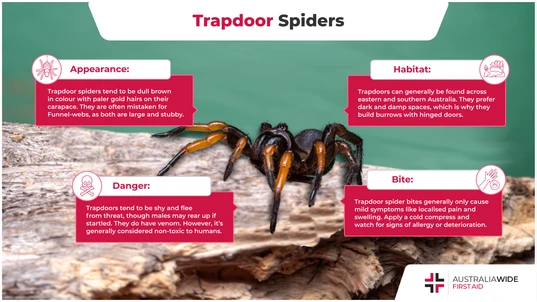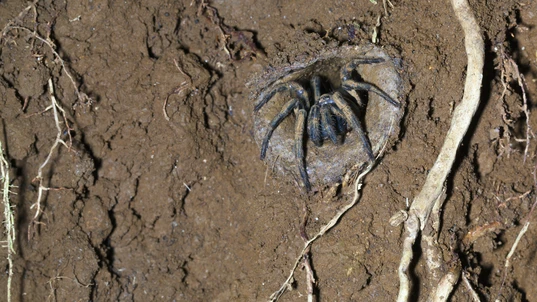Trapdoor Spiders: The Tunnel-building Arachnid

Bites and Stings

Trapdoor spiders are widely distributed across the world, though the most well-known species can be found in Australia and the United States. They are often confused with Funnel-web spiders. But are they just as dangerous? Let's take a look.
Despite being known for their unique trapdoors based at the entrance of their burrows, not all trapdoor spiders make a door for their burrows. Rather, the trapdoor spider is a common name for any several large, hairy, and generally harmless tropical spiders that nest underground.All About the Trapdoor Spider
The common name covers several families of spiders including the Idiopidae, Actinopodidae, Ctenizidae, Migidae and Cyrtaucheniidae. The most common trapdoor spiders such as the Brown Trapdoor and Spotted Trapdoor belong to the family Idiopidae. The brown trapdoor spider, and the most popularly known spider, is primarily found around Sydney, Australia. This spider is often mistaken for the far more dangerous Funnel-Web Spider due to similar identifying features such as being both large, dark, and rather stubby with a hairy coat. These spiders are common in gardens, and are found across Eastern and Southern Australia, including Tasmania. They often prefer dark and damp spaces, and their burrows can be found while moving rocks or digging soil. Trapdoor spiders normally spend their entire life inside the burrow with females being able to live up to 20 years long while males have a much shorter life. After 2 or 3 years, trapdoor spiders often leave their burrows in late autumn to early winter to roam the outside world in search of a potential mate. While there are many different species of trapdoor spiders, some don’t make a hinged door at the entrances at their burrows. However, one thing they all have in common: they dig a burrow that acts as both a home and a ‘trap’ – awaiting their next victim patiently in the safety of the ground.Identifying a Trapdoor Spider
While you are unlikely to see a trapdoor spider due to their shy nature, you may notice some similar identifying features with the funnel-web spider. They usually flee from any threat, however, it’s good to exercise extreme caution and recognise the difference between the trapdoor and their dangerous cousins. Here are some identifiers that are typical of the trapdoor spider:- Medium body lengths that can grow up to 3.5cm long
- Short and blunt spinnerets (the silk-spinning organ of the spider)
- Males often have a small double spur halfway along their first leg, while females are larger than the male
- Dull brown with a cover of paler gold hairs on the carapace (upper shell covering the front part of their bodies)
- Pale bars across the abdomen
- Eyes arranged in two compact rows
- Males have large palps similar to large boxing gloves near their mouth to be used for mating
Trapdoor Spiders and Their Hunting Habits
Trapdoor spiders feed by waiting for unsuspecting victims to wander past their burrows with the door open just a crack. Once the prey is in sight, these spiders leap out at great speeds to seize its prey before hauling it back into the burrow to be devoured – all in the blink of an eye. On the other hand, these trapdoors also make a great hiding spot from dangerous predators such as birds, bandicoots, centipedes, scorpions, parasitic wasps, and flies. When the trapdoor is closed, the spider’s home is very well hidden. Trapdoor spiders often spend their time using silk, dirt and bits of moss or plants to camouflage their ingenious trapdoors. There are little holes in the bottom of the trapdoor that enables these spiders to hold onto the door using their legs – these can be used to push the door open or to hold the door closed in case a predator may try entering their burrow. These spiders also play an important role in controlling the number of cockroaches, beetles, crickets, and even other spiders. Generally, they are not considered to be a major threat to humans. If you see a small burrow in the ground lined with silk roughly 250mm in depth and 25mm in width, it’s best to leave them alone to tend to the local garden pests.
Trapdoor spiders must leap out at great speeds to catch unsuspecting prey before they escape.
Are Trapdoor Spiders Dangerous to Humans?
While trapdoors tend to be shy and flee from any threat, males may rear up if startled unexpectedly. A bite from a Brown Trapdoor Spider may cause some local pain and swelling to the area but generally will not cause any complications. Sigillate Trapdoor Spiders on the other hand may also cause local pain and swelling. However, it’s recommended to exercise caution and apply a cold pack to relieve the pain if needed. If these symptoms persist, seek medical attention as soon as you can. Because of their similarities with funnel-web spiders, it’s recommended to collect the spider for a positive identification in the event of a bite. Whether they’re threatening or non-threatening, it’s always a good idea to give spiders a bit of space whenever you can. Better to be on the safer side of things! Continue reading for a full outline of the correct first aid procedure for a Trapdoor Spider bite.First Aid for a Trapdoor Spider Bite
Trapdoor spider bites should be treated in the same manner as a Funnel-web spider bite, as there are approximately 40+ varieties of large black spiders, so it is worthwhile to treat for the worst and hope for the best:- Keep the casualty at rest and as still as possible to stop the venom from travelling through the body.
- Constantly observe and reassure the casualty.
- Follow DRSABCD and be prepared to perform CPR
- Apply the ‘pressure immobilisation technique’ (PIT):
If the bite site is on a limb, cover it with a wide heavy elastic bandage (10 - 15 cm wide).
Ensure the bandage is firm and tight, so tight you cannot easily slide a finger between the bandage and the skin.
Apply a second heavy elastic bandage. Start from the fingers or toes and wind up the limb as far as possible. Consistent coverage (overlapping half over half) and consistent pressure (firm but not cutting off circulation) are key to an effective PIT. - Immobilise the limb and joints with a splint, or use a sling if the bite site is on an arm. Keep the limb immobilised until the ambulance arrives.
Spider Bites and Anaphylaxis
If the casualty begins exhibiting signs of a severe allergic reaction, otherwise known as anaphylaxis, call Triple Zero (000) for an ambulance, consult the Australian Resuscitation Council's anaphylaxis treatment guideline, and follow DRSABCD and be prepared to perform CPR.Trapdoor Spider Fun Facts
- Trapdoor spiders do have venom as well! It’s just not dangerous to humans, but can be fatal to small insects
- Trapdoor spiders are nocturnal creatures and prefer to hunt in the shadows of the night
- There are more species of trapdoor spiders in Australia than any other country (i.e. India, Madagascar, New Zealand, North America, and South America)
- According to a study published in the Invertebrate Systematics, 5 new trapdoor spider species have been discovered in Australia
- Small-headed flies are one of the largest threats to trapped door spiders as these parasitic flies will attach itself to the leg joints of the spider and feed from the spider as it grows.
Conclusion
Trapdoor spiders are mainly harmless and mind their own business throughout the gardens and bushlands in Australia. However, it’s never a good idea to go looking for them as you may receive a nasty bite when encountered. These wild animals can be unpredictable, and it’s recommended for you to learn first aid in the event of a serious bite. Make sure to attend one of our First Aid Courses to learn more about treating various spider bites and what to do in case of an emergency.Recommended Resources
We also have articles on what to do if you get stung or bitten by a snake, fire ant, and different types of marine life. And for more details on how to identify and treat bites from some of Australia's deadliest spiders, including White tail spiders, Wolf spiders, Huntsman spiders, and Redback spiders, head to our Resource Library. Disclaimer: This article is for informational purposes only. It does not constitute, replace, or qualify as any form of first aid training.
Originally published at
https://www.australiawidefirstaid.com.au/resources/trapdoor-spiders
as part of the Australia Wide First Aid Articles Library









